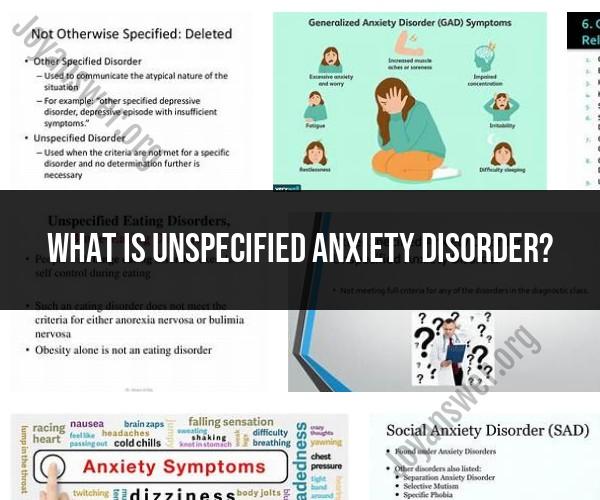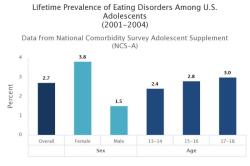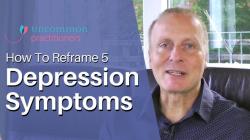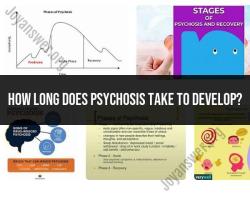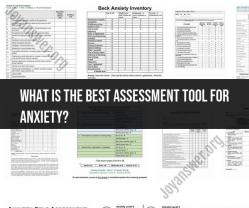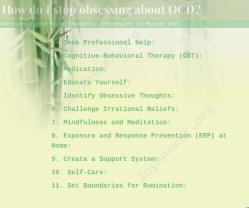What is unspecified anxiety disorder?
"Unspecified Anxiety Disorder" is a diagnostic category used in mental health and psychiatric practice to describe a form of anxiety disorder when the specific subtype or diagnosis within the anxiety disorder spectrum is not clearly identified or when the symptoms do not fit the criteria for any specific anxiety disorder. It is sometimes referred to as "Anxiety Disorder Not Otherwise Specified" (ADNOS) or "Other Specified Anxiety Disorder."
Here are some key points about unspecified anxiety disorder:
Diagnostic Ambiguity: Unspecified anxiety disorder is diagnosed when an individual experiences significant anxiety-related symptoms but does not meet the criteria for a specific anxiety disorder, such as generalized anxiety disorder (GAD), panic disorder, social anxiety disorder, or specific phobias.
Diverse Symptoms: People with unspecified anxiety disorder may exhibit a wide range of anxiety-related symptoms, which can include excessive worry, restlessness, irritability, muscle tension, sleep disturbances, and heightened arousal.
Reasons for Diagnosis: There are several reasons why a healthcare professional might diagnose unspecified anxiety disorder:
- The symptoms may not fit the criteria for any specific anxiety disorder.
- The symptoms may be too generalized or fluctuating to pinpoint a specific diagnosis.
- The individual may have symptoms of anxiety that do not meet the full criteria for another anxiety disorder but are still causing significant distress or impairment.
Treatment Approach: Treatment for unspecified anxiety disorder often involves therapeutic interventions, such as cognitive-behavioral therapy (CBT), psychotherapy, relaxation techniques, and lifestyle modifications. Medications, such as antidepressants or anti-anxiety medications, may also be considered, depending on the severity of symptoms and individual factors.
Individualized Care: The treatment plan for someone with unspecified anxiety disorder is typically tailored to their specific symptoms and needs. It's essential for healthcare professionals to work closely with the individual to address their unique challenges and provide appropriate support.
Follow-Up and Reevaluation: As the individual progresses in treatment or as their symptoms change, healthcare providers may reevaluate the diagnosis and consider more specific anxiety disorder classifications if warranted.
It's important to note that a diagnosis of unspecified anxiety disorder does not mean that the individual's symptoms are any less real or impactful. Anxiety disorders, including unspecified anxiety disorder, can significantly affect a person's quality of life and well-being. Seeking professional help, such as from a mental health counselor or psychiatrist, is crucial for proper assessment, diagnosis, and management of anxiety-related symptoms.
Unspecified Anxiety Disorder: What You Need to Know
Unspecified anxiety disorder is a diagnosis given to people who experience symptoms of anxiety that do not meet the full criteria for any other specific anxiety disorder. This means that unspecified anxiety disorder is a broad category that can include a variety of different presentations of anxiety.
Some common symptoms of unspecified anxiety disorder include:
- Excessive worry
- Restlessness
- Difficulty concentrating
- Fatigue
- Irritability
- Muscle tension
- Sleep problems
Unspecified anxiety disorder can be caused by a variety of factors, including genetics, brain chemistry, and life experiences. It can also be triggered by stress, trauma, or medical conditions.
Anxiety Diagnosis: Insights into Unspecified Anxiety Disorder
To diagnose unspecified anxiety disorder, a healthcare professional will typically ask about a person's symptoms, medical history, and social history. The healthcare professional may also perform a physical examination and order laboratory tests to rule out any underlying medical conditions.
In order to meet the criteria for unspecified anxiety disorder, a person must experience at least three of the following symptoms for at least six months:
- Excessive worry
- Restlessness
- Fatigue
- Difficulty concentrating
- Irritability
- Muscle tension
- Sleep problems
The symptoms must also cause significant distress or impairment in the person's social, occupational, or other important areas of functioning.
Anxiety Spectrum: Understanding Unspecified Anxiety Disorder
Unspecified anxiety disorder can be thought of as being on an anxiety spectrum. At one end of the spectrum are mild cases of anxiety that do not significantly interfere with a person's life. At the other end of the spectrum are severe cases of anxiety that can make it difficult for a person to function in their daily life.
Unspecified anxiety disorder typically falls somewhere in the middle of the anxiety spectrum. It is important to note that unspecified anxiety disorder is still a valid diagnosis, and it should be treated accordingly.
If you are concerned that you may have unspecified anxiety disorder, it is important to see a healthcare professional for diagnosis and treatment. There are a number of effective treatments available for anxiety disorders, including therapy, medication, and lifestyle changes.
